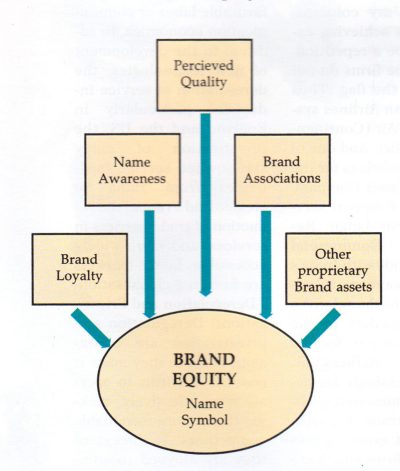Ajai V Singh
Advertising Brand Equity is a term that widely echoes from echelons of corporate houses to the dwell of various brand and marketing executives. Corporate incumbents have realized the value of the brands and the equity it should hold in order to ensure profitability to the company as a whole. So much so, that one of the favorite expressions of the brand managers the world over is ‘We have to build brand equity.’ The majority of them say it in a frivolous manner as they all have short-term perspectives – which is a detour from the path of building brand equity.
What is Brand Equity?
First what do we mean by ‘equity’? According to the Penguin economic dictionary – ‘the residual value of a company’s assets after all outside liabilities (other than to shareholders) have been allowed for.’ In the same way, brands hold certain value that is attached to them. It is financial as well as intangible. Brands have also become a criteria for prospective shareholders looking for a suitable company to invest in. Brand Equity spells out the value that can be attached to a brand. In the words of David Aaker (1991), ‘Brand Equity is a set of brand assets and liabilities linked to a brand, its name and symbol, that add to or subtract from the value provided by a product or service to a firm and/or to that firm’s customer.”
Building brand equity is a long drawn process as most of the assets involved are intangible, and show profitability over a long period of time. On the other hand a ‘perfect’ company situation demands short term results.
The ‘Assets’ Some of the prominent intangible assets associated with the brand are the brand name and the value the

consumer perceives from it. For instance, the name Mercedes-Benz gives you an enormous amount of value, if we take the Mercedes name away from its parent Daimler Benz. What are you left with, a company in Germany that makes car and airplane engines! The perceived value of the brand is what leads to brand extensions. For example, Maliban a renowned name in biscuits brings with it a perceived value. The company has exploited that value and extended its sphere to milk powders which are named ‘Maliban’. The perceived value also brings with it a certain amount of loyalty towards the brand. The term ‘loyalty’ can be labeled as a strong determinant of long term profitability and also plays an important role in gaining brand equity. The brand Elephant House enjoys tremendous brand equity in Sri Lanka and this can be judged on all the parameters mentioned above. This equity which the MNC brands will find very difficult to erode, has been built over a long period of time.
Grey Worldwide has developed a unique index called Brand Loyalty. This index is on the same level as the Fortune 500 index or the Standard & Poor stock index. This index has been developed by the agency to study and track brand loyalty among consumers of different categories. This index provides important information for marketing outfits in terms of, their brand being affected by lack of consumer loyalty, and subsequently to develop marketing and communication plans to achieve loyalty for the respective brands.
Quite a few writers have shed light on the issue of brand loyalty, prominent among them is David Aaker who has diagrammatically represented the important categories that can be grouped together to determine a brand’s assets or liabilities:
Brand Equity

The five categories that underlie brand equity are brand loyalty, name awareness, perceived quality, brand associations in addition to perceived quality and other proprietary assets-patents, trademarks, channel relationships, etc.
Brand loyalty as mentioned above, reduces vulnerability to competitive action. This might lead to competitors being discouraged from spending resources to attract satisfied customers. Existing customers also provide brand exposure and reassurance to new customers. Awareness of a particular brand scores over an unknown brand. Further on, people often buy a familiar brand because they are comfortable with the familiar. One assumption, based on the familiarity can be derived from the fact that a familiar brand is reliable and is of reasonable quality. Perceived quality is of great importance as it directly influences purchase decisions and brand loyalty at the time when there is no motivation or lack of detailed information, for the buyer. It also supports premium price and can also be a basis for brand extension. Associations are always linked to a brand in a unique way. Nike’s association is with a passion to win, the advertising theme says ‘just do it’. Aspirin’s association is of ‘use context’ with heart-attack prevention that can provide a reason-to-buy which can attract customers. An association can be a barrier to competitors. Other Proprietary brand assets are more specific to patents, copyrights etc. They prevent direct competition and the eroding of customer base.
There are numerous ways devised to value a brand, from premium pricing and replacement cost to the time the brand has been in existence. The time factor, which confirms that products have a life cycle whereas brands live for ever, is proved by brands like Ivory soap from P&G which is in existence for the last 110 years. It has been a source of value to the company for as many years. Building brand equity takes time and that is not acceptable to managers the world over. They are driven by short-term goals. Some of them try to embark on this process, but fail to sustain it as they are judged on their short- term performances. But what is surprising is that, though most of the brand and marketing managers are driven by short-term objectives, the very brands from where they derive their inspiration are all a result of a long-term brand building process. They can be named as Coca Cola, Marlboro, Maliban, Nike etc. They have gained brand equity after years of work- ing towards building name, loyalty, awareness and quality. These factors are a result of consumer led product innovation and communication. It is quintessential for brands, who are trying to gain equity, to follow long-term objectives rather than short-term. gains.
Ajai V Singh who is currently working with Trikaya Grey, did his MBA in International Business from Sydney, Australia. He has worked in Australia and India before being transferred to Colombo with the Multinational Advertising House, to look after the company’s multinational accounts.


